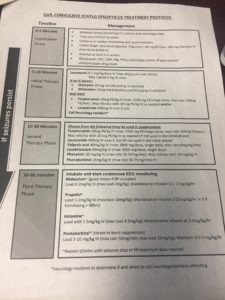Had an interesting case recently while I was working at Jewish Downtown. Approximately 50s male presents in acute respiratory distress. Apparently he rented out some apartments and one of the tenants clogged one of the toilets, I didn’t have a chance to ask how.
Anyway, in an attempt to fix the problem he mixed two plumbing agents: Liquid Fire Drain Opener & some other generic drain-o liquid that he planned to use to clear the pipes. This ended up being a bad idea and a chemical reaction occurred releasing a cloud of chlorine gas. The patient inhaled this and began becoming progressively more short of breath.
While en route, EMS initially had him on a nasal cannula but transitioned him to a non-rebreather as well as a Duo-neb. At the time of his arrival to room 1 the patient was in obvious respiratory distress, diaphoretic, and anxious pulling at the non-rebreather and leads. His O2 sat was from 86%-88% on the non-rebreather with decreased breath sounds diffusely. We elected to intubate the patient with etomidate as our induction agent and rocuronium as our paralytic. After the patient was placed on the ventilator we started the patient on nebulized sodium bicarbonate.
This was something I had never done before – so I wanted to discuss chlorine gas inhalational injuries and the role of nebulized bicarb.
Chlorine gas inhalations typically occur in the setting of chemicals for cleaning an indoor pool. Chlorine gas inhalation rarely progresses to respiratory distress requiring intubation.
In 1994 the Journal of Clinical Toxicology did a two year retrospective review of 86 cases of chlorine gas inhalation and none of the patients progressed to respiratory insufficiency requiring ventilator support. The most common symptoms are cough, chest pain, and shortness of breath and the chest xray is often unrevealing. In the study all 86 cases received nebulized sodium bicarbonate and none of the patients clinically deteriorated or acutely worsened as a result of the treatment.
While the nebulized bicarb does not reverse or work to eliminate the inhaled chlorine, it helps symptomatically with the cough and SOA. I could not find much information on the MOA or science behind the use of nebulized sodium bicarbonate but it appears to be pretty safe.
The dosing that I found is 4mL of 4% nebulized NaHCO3, and be prepared to explain this to the respiratory therapist because this is not something that they do often. Also this has to come up from pharmacy as code cart sodium bicarb is typically 7.5% so the concentrations are different.
So our patient received his nebulized bicarb once it came up from pharmacy. He was admitted to the ICU and I have not had a chance to follow up on his outcome yet. I just thought this was an interesting case and something that I had not yet encountered and figured I would share for your reading pleasures.
![Room9er ["Room Niner"]:](https://room9er.com/wp-content/uploads/2020/03/cropped-Screen-Shot-2020-03-08-at-3.16.16-PM.png)
